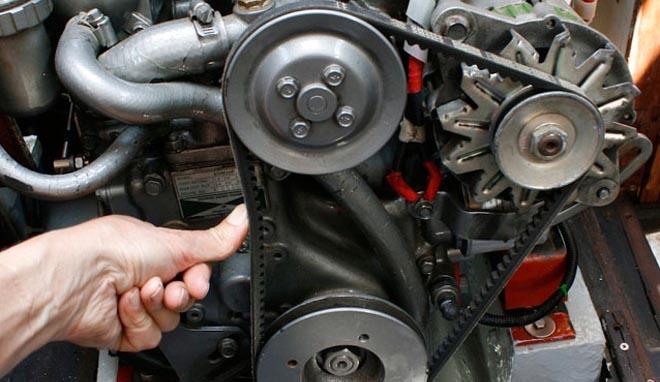Love your sailing boat's belts and they will love you in return
by Des Ryan/ Sail-World Cruising round-up on 16 Apr 2013

Tension should be ’just right’ in the belt SW
When did you last replace the belts in your sailing boat's diesel engine? You didn't? Then you are waiting for the belt to snap just when you need it least. Let's face it, belts are not so expensive, and changing them regularly, rather than waiting until they snap, is the smart road to trouble free sailing.
Not that these belts - the alternator, auxiliary alternator, raw-water pump and circulator pump — won't typically provide really reliable and trouble-free service as long as they are properly maintained. But they do have a life, and replacing them on a sunny day in harbour is a comparatively pleasant job, compared with doing the same job in a lumpy sea when there's a crew, or worse, guests, wanting to get home.
The belts used to drive these accessories are of the 'V' variety or ribbon-shaped flat serpentine belts. Often, one V belt may do double duty, sending life from the crankshaft pulley to both the alternator and coolant pumps, while another belt will help drive the raw-water pump.
You can help elongate the life of a belt of course. One of the most important factors that affects belt life is making sure it is properly tensioned when it is installed, that the proper tension is maintained throughout its service life and it doesn't slip.
The regular inspection:
1. Check that the belts are tight — tight enough so they don’t slip, but no tighter. Follow the manufacturer’s recommendation for belt tension, don't just guess, or use old-fashioned 'rule of thumb' rules. If a belt is slipping, it won’t turn its related accessory properly, and it will wear out and break prematurely. If it’s too tight, it will accelerate wear on bearings and seals. If you see any evidence of belt dust on the front of the engine or the alternator casing, the belt is either slipping or misaligned. If the belt and/or pulley shows signs of glazing — a particularly smooth, shiny appearance — it means the belt is slipping. A glazed belt must be replaced, but the glaze on a pulley can be 'dressed' using 220-grit sandpaper.
Correcting the tension:
To tension a belt, use a breaker bar as a lever to pry the accessory away from the crankshaft pulley, and then tighten the fixing bolt. Threaded 'spreader' tools are available to make this task easier. Finally, ensure that each belt’s profile properly matches every pulley over which it turns. The belt should be even with, or stand slightly proud, no more than 1/16 inch, from the top of the pulley walls.
Self-adjusted tension and pulley bearings:
On engines with a single serpentine belt, tension is usually self-adjusted automatically via a spring-loaded tensioner. No additional adjustment is necessary. If this is the case, check the tension pulley bearing. When the belt is removed, the pulley must spin freely with no rough spots detected under hand pressure.
Continually replacing belts?
If this is the case, misaligned pulleys could be your problem. Alignment can be checked with a straightedge. If a pulley is bent or not on the same plane as the rest, the problem should be corrected, or the 'bad' pulley will continue to ruin belts.
Allowing a tired belt to keep working: Give your belts the break they need. Deteriorating belts can cause collateral damage to the alternator. A chronically slipping alternator belt can create large amounts of fine dust. The issue arises when this belt dust is drawn into the alternator with the cooling air. If the rubber dust-like debris makes contact with the hot components within the alternator, it will melt and adhere to them, creating a harmful insulating blanket coating the bearings, windings, diodes and heat sinks, potentially causing failure. Not a nice outcome!
How often should they be replaced?
As belts are pretty cheap in the scheme of things, it’s wise to replace them, say, during the annual check. Never leave them past 2,000 hours, whichever comes first. Having said that, it's also wise to replace them when you are embarking on a long voyage. But not JUST before you go, because in the first 50 to 100 hours of use the belt may need retensioning or some adjustment. So do it well enough in advance so that you can trouble-shoot before you leave.
Do all of the above and you are giving yourself the best chance of carefree sailing.
If you want to link to this article then please use this URL: www.sail-world.com/108463